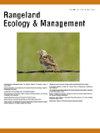Spatial Scale Dependence of Error in Fractional Component Cover Maps
IF 2.4
3区 环境科学与生态学
Q2 ECOLOGY
引用次数: 0
Abstract
Geospatial products such as fractional vegetation cover maps often report overall, pixel-wise accuracy, but decision-making with these products often occurs at coarser scales. As such, data users often desire guidance on the appropriate spatial scale to apply these data. We worked toward establishing this guidance by assessing RCMAP (Rangeland Condition Monitoring Assessment and Projection) accuracy relative to a series of high-resolution predictions of component cover. We scale the 2-m and RCMAP predictions to various focal window sizes scales ranging from 30 to 1 500 m using focal averaging. We also evaluated variation in scaling effects on error at ecoregion and pasture (mean area of 1 050 ha) scales. Our results demonstrate increased accuracy at broader windows, across all components, and most increases in accuracy level off at ∼200–600 m scales. At the scale with highest accuracy, cross-component average correlation (r) increased by 6.5%, and root mean square error (RMSE) was reduced 46.4% relative to 30-m scale data. Scaling-related improvements to accuracy were greatest in components such as shrub and tree with more spatially heterogeneous cover and in ecoregions with more spatially heterogenous cover. When components were aggregated at the pasture scale, r increased 10% and RMSE decreased 34.3% on average relative to the 30-m scale. Our results provide empirical data on the scale dependence of error, which fractional cover data users may consider alongside their needs when using these data. Although the general principle remains that remotely sensed products are intended to address landscape-scale questions, our analysis indicates that applying data at finer than landscape spatial scales and grouping even a handful of pixels resulted in lowered error compared to pixel-level comparisons. Our results quantify the trade-offs between data granularity and error related to scale for fractional vegetation cover.
分数分量覆盖地图误差的空间尺度依赖性
地理空间产品,如植被覆盖度地图,通常报告总体的、逐像素的精度,但这些产品的决策往往发生在更大的尺度上。因此,数据用户通常希望在适当的空间尺度上得到指导,以应用这些数据。我们通过评估RCMAP (Rangeland Condition Monitoring Assessment and Projection,牧场状态监测评估与预测)与一系列高分辨率组件覆盖预测的准确性,努力建立这一指导方针。我们使用焦平均将2米和RCMAP预测缩放到30至1 500米的各种焦窗尺寸尺度。在生态区域和草地(平均面积为1 050 ha)尺度上,我们还评估了尺度效应对误差的影响。我们的结果表明,在更宽的窗口中,所有组件的精度都有所提高,并且在~ 200-600米尺度上精度的大部分增加趋于平稳。在最高精度尺度下,相对于30 m尺度数据,跨成分平均相关系数(r)提高了6.5%,均方根误差(RMSE)降低了46.4%。与尺度相关的精度提高在空间异质性覆盖较多的灌木和乔木组分和空间异质性覆盖较多的生态区中最大。在牧场尺度上,相对于30 m尺度,r平均提高10%,RMSE平均降低34.3%。我们的研究结果提供了误差的尺度依赖性的经验数据,当使用这些数据时,部分覆盖数据用户可能会考虑他们的需求。虽然一般原则仍然是遥感产品旨在解决景观尺度的问题,但我们的分析表明,与像素级比较相比,应用比景观空间尺度更精细的数据和分组甚至少量像素会导致更低的误差。我们的结果量化了与植被覆盖度相关的数据粒度和误差之间的权衡。
本文章由计算机程序翻译,如有差异,请以英文原文为准。
求助全文
约1分钟内获得全文
求助全文
来源期刊

Rangeland Ecology & Management
农林科学-环境科学
CiteScore
4.60
自引率
13.00%
发文量
87
审稿时长
12-24 weeks
期刊介绍:
Rangeland Ecology & Management publishes all topics-including ecology, management, socioeconomic and policy-pertaining to global rangelands. The journal''s mission is to inform academics, ecosystem managers and policy makers of science-based information to promote sound rangeland stewardship. Author submissions are published in five manuscript categories: original research papers, high-profile forum topics, concept syntheses, as well as research and technical notes.
Rangelands represent approximately 50% of the Earth''s land area and provision multiple ecosystem services for large human populations. This expansive and diverse land area functions as coupled human-ecological systems. Knowledge of both social and biophysical system components and their interactions represent the foundation for informed rangeland stewardship. Rangeland Ecology & Management uniquely integrates information from multiple system components to address current and pending challenges confronting global rangelands.
 求助内容:
求助内容: 应助结果提醒方式:
应助结果提醒方式:


